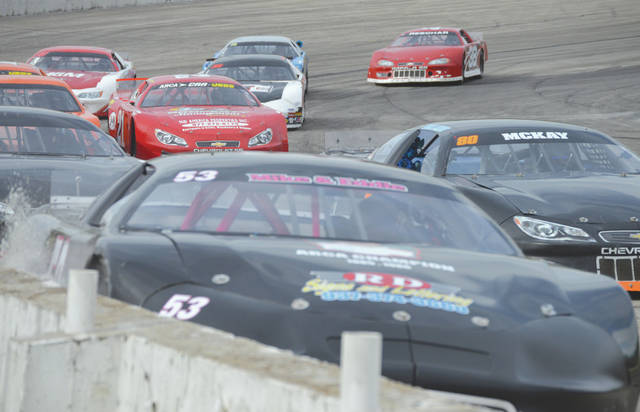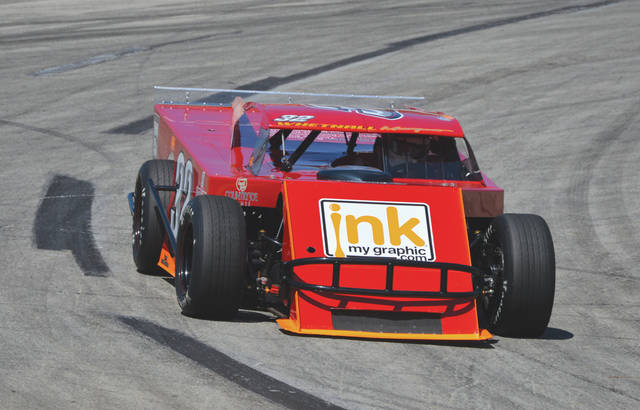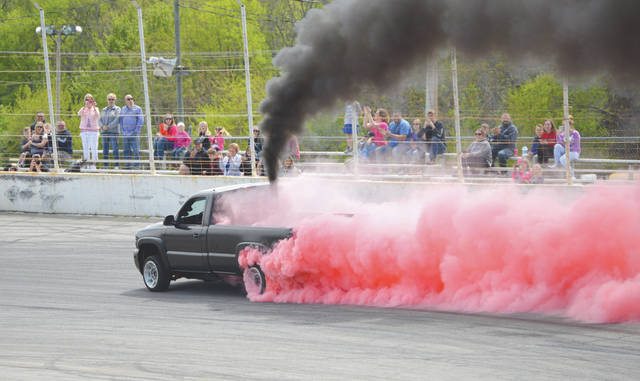


XENIA — In his second week of running expensive race cars through the Kil-Kare Raceway tech line, Gem City Auto Racing series technical director Donnie Renner felt pretty good about the progress the series had made.
Sunday’s April 23 racing event at Kil-Kare featured more cars, more fans, more entertainment and fewer lines awaiting Renner and his technical crew at the weighing scales. The fledgling GCAR crew improved from the series’ debut two weeks ago.
“There’s a lot of hard work that’s put into this, but still we have a lot of hard work to go. But we knew that coming in,” Renner said, during a break in technical inspections of the four classes of race cars prior to Sunday’s races. “Us old racers know what the guys like, and we know what we have to do. I know it takes a lot of work for the teams to get these cars ready, but it takes a lot to put on a show also.”
At opening day back on April 9, cars were sometimes queued up 8-9 deep as they awaited their turn for the mandatory pre-qualifying inspection. No such log jams were seen on April 23.
Another nice change was the intensity shown by the GCAR crew in the Jerry Wahl press tower in keeping the day’s events running efficiently. When a couple incidents in some early heat races put the day’s racing schedule behind by nearly a half an hour, the GCAR officials cut the break between the heat races and the features down to roughly 15 minutes.
A race drifting demonstration took place during one break, drawing cheers from the crowd.
“We do the same thing we used to do when we raced,” Renner explained. “We take a lot of notes, and find stuff we can improve upon week by week. … We’ve got some bumps in the road, but we’re getting to ‘em as we go. The background we’ve got, with the guys working here, there’s a lot of racing experience, just not a lot of experience in running the show just yet.”
Kudos to the two gentlemen in the press tower who learned how to work the transponder computers on the fly on Sunday afternoon. Much of the computer software in the tower was archaic when the track closed for business two years ago. It’s the same software being used so far this season.
Some drivers ended up re-qualifying, all because the software wouldn’t always pick-up the signal from the more modern car transponders. Unfazed, the GCAR tower crew simply had those drivers — Bill Cantley, in the late model qualifying; David Stump and Josh Longstreth in Sports Stocks — move to the end of the qualifying order and re-qualify.
And the car counts were up!
After having seven Compact cars at Race One, there were 13 on Sunday. Sport Stock entries doubled from five on opening day to 10. Even the Modified division, despite having a dozen cars ready for the opening race, they had 14 for Race Two. Late Models increased in number from 11 to 15.
There were more cars in the paddock area, and they competed from space with several drag racing teams that were sharing the area. But there were fewer lines everywhere, another tribute to the GCAR staff.
Staffers even hustled the final race results back from the tower to the paddock area quickly, to enable the drivers to get paid sooner than last time.
“We’re getting things running pretty well. If you’ve got good help from good people, you’re gonna have a pretty good outcome. And that’s what we’ve got,” added Renner.
Speaking of good outcomes, two GCAR series race drivers have yet to lose this season: Beavercreek’s Jack Jones repeated as the Modified feature winner, and Xenia veteran driver Ryan Fleming two-peated as the Late Model division feature winner.
Two new winners were crowned in the Compact and Sports Stock divisions. Columbus drivers Jacob Muncy (Sports Stock) and Trey Gregory (Compacts) claimed feature wins on Sunday.
Race 3 of the 11-race GCAR schedule is scheduled to take place on May 7 at Kil-Kare Raceway.




